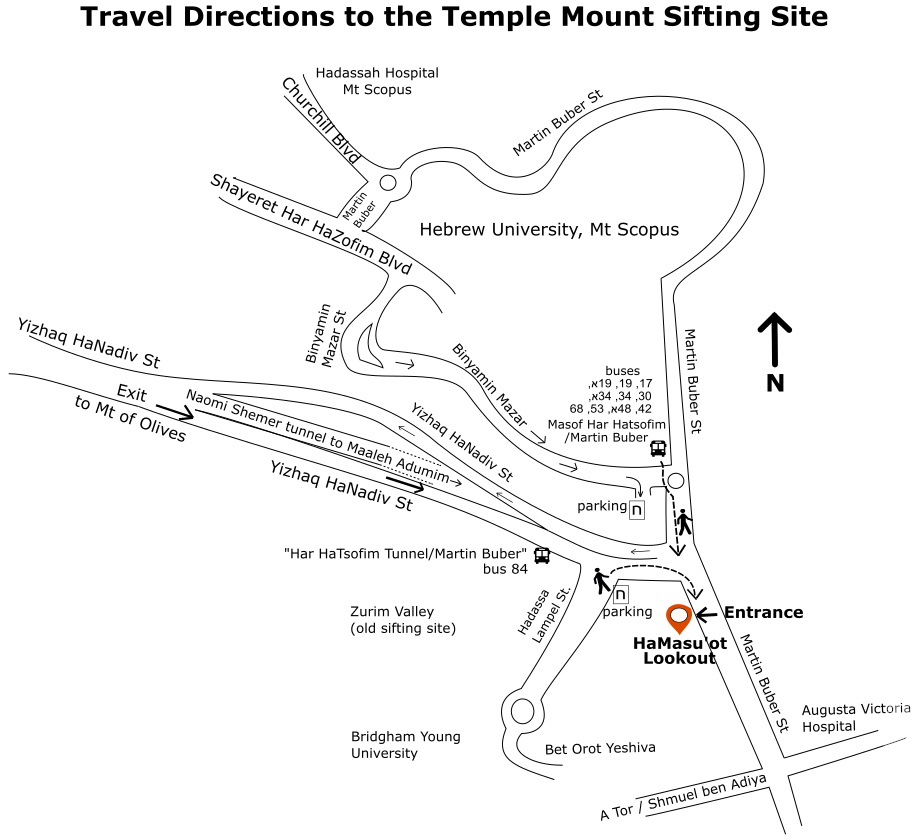How to Participate in the Sifting?
How Does It Work?
Participation in the Temple Mount Sifting Project is a two hour program which includes an introductory lecture and sifting guidance, the sifting itself and a summary during which the guide explains the significance of finds recovered by the group. Each bucket sifted contains artifacts from all historical periods of the Temple Mount.
The sifting work does not require physical exertion and participants are not expected to get dirty, but they may get wet. Site conditions are suitable for all seasons of the year. Even during a heatwave the weather is pleasant at the site – Mitspeh HaMasu’ot is situated at the highest point in Jerusalem and thus benefits from a welcoming breeze. Working with water in the wet sifting also aids to reduce the heat.
Important Note: The Temple Mount Sifting Project has moved and is no longer in our former facility at Zurim Valley National Park, which continues to operate as an archaeological sifting facility for soil from other sites (not the Temple Mount)
Further Details
Opening Hours
Visits must be reserved in advanced. On some days the sifting is closed – the most updated opening hours appear in the booking interface below.
The site can be opened at times (including Fridays) not appearing in the booking interface, for a minimum opening fee. To coordinate the visit of a group, contact: booking@tmsifting.org, or call: 02-5665491.
Prices
Participants Prices:
- ₪40 per adult (aged 18 and above)
- ₪30 per child (aged 7–18)
- No Charge: Children under the age of 7
- During Holidays: ₪20-30 per member in family visit of 3 children (aged 7-18) or more. Make sure to change the adult ticket number to zero.
Location and Directions
The sifting site is located in Mitzpeh HaMasuot, on Martin Buber St on the junction with Yizhaq haNadiv St (above the tunnel to Maaleh Adumim) , Jerusalem (google maps link). If you are experiencing difficulty in reaching the site, call the staff on 02-566-5491 (from a non-local telephone: +972-2-566-5491).
By public transport:
The site is a short walking distance from the following bus stops:
“Mount Scopus Terminal/Martin Buber, on buses 17, 19, 19A, 30, 34, 34A, 42, 48A, 53, 68
“Har HaTsofim Tunnel/Martin Buber”, on bus 84
Important note: Do not get off the bus at the Hebrew University stop. You should get off at the final stop at Martin Buber St.
By car:
Directions to parking lots in the vicinity of the sifting site:
Paid parking – in the Hebrew University parking lot, at the end of Binyamin Mazar St. (google maps link / waze link) – to pay you will need the cellopark application on your mobile phone. After parking, cross the street in the direction of the sifting site which is surrounded by a fence of metal poles. A brown sign points to the site.
Free parking – in Hadassah Lampel St. (google maps link / waze link). Park at the beginning of the street, then return by foot to the start of the street, turn right and right again towards the sifting site entrance. N.B. do not walk in the direction of the Emek Zurim national park.
Please note – you cannot drive in the reverse direction directly back from the sifting site itself to Hadassah Lampel St.
Volunteering
We welcome volunteers. Because training requires a significant investment, we ask for a long-term commitment—such as one day per week. Volunteers should be prepared for physically demanding tasks or office work (e.g., labeling pottery sherds). On site, volunteers receive two weeks of training that enables them to accompany groups and verify visitors’ sifting results.
We do not provide transport or meals for volunteers, who are asked to make their own way to the site and to bring their lunch.
Please check in advance whether we currently need volunteers by calling +972-2-566-5491 during working hours or emailing contact@tmsifting.org
Volunteers who would like to volunteer at our lab are may apply by sending their resume/CV to: contact@tmsifting.org. We will make contact with you if you meet the necessary requirements.
We are currently looking for help in the following areas: counting artifacts and data entry, studio photography, graphical editing and programming in Visual Basic in ACCESS, Php and SAS.
Archaeological students interested in helping out voluntarily as research assistants are likewise welcome to send us their resume.
Additional Tour Programs
For groups who wish to receive an enriched activity and a guided tour, we can provide the following programs:
- A tour of nearby sites including: the Augusta Victoria lookout tower, the Yehudai Lookout and the Mount Scopus botanical garden, including the Cave of Nicanor.
- An in-depth presentation covering the history and archaeology of the Temple Mount, including key artifacts recovered by the sifting project.
- A full day walking tour highlighting the archaeology of the Temple Mount, including: A comprehensive archaeological tour of the Temple Mount*, the royal compound at the Ophel dated to the First Temple Period and the Jerusalem Trail (including the monumental tombs of the Kidron Valley, the Valley of the Kings and the Emek Tzurim National Park, ending at the sifting site at the Masu’ot Lookout). At the sifting site the group will receive an in-depth presentation on the Temple Mount Sifting Project and its finds, together with participation in the sifting activity.
*For those preferring not to enter the Temple Mount we offer an alternative tour including a walk around the Temple Mount’s walls and the Davidson Center.
For additional information regarding these programs please contact us at booking@tmsifting.org or +972-2-5665491
Mitzpeh HaMasu‘ot (The Masu’ot Lookout)
The new sifting facility is located in a scenic pine grove at the meeting point of Mount Scopus and the Mount of Olives, not far from the Hebrew University campus.
The site is positioned on top of the mountain range separating Jerusalem from the Judean Desert and provides a magnificent panoramic view of the city. During the Second Temple Period, the first beacon (Masu’ah), announcing the birth of the new Hebrew month, was lit in this area. The site, with its convenient picnic tables and bathroom facilities, is often utilised by sightseers exploring the area. The site’s auditorium building also houses a painting exhibition as well as a display of some of the Temple Mount artifacts discovered in the sifting project.
Other nearby attractions to enjoy include the lookout tower at the Augusta Victoria church-hospital which provides a magnificent view of Jerusalem and the Judean Desert (open until 1 pm), the beautiful botanical garden at the Hebrew University’s Mt Scopus campus, which also contains the burial tomb of Nicanor who famously donated gates to the Temple, and the Yehudai Lookout facing the Judean Desert. Mitzpeh HaMasu’ot is also the starting point of the Jerusalem Trail.





